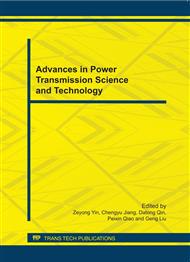p.797
p.801
p.805
p.809
p.813
p.817
p.821
p.825
p.829
Initial Behavior of Speed Increasing Helical Gears by Torque Fluctuation
Abstract:
This work studied initial impact behavior of speed increasing helical gears with backlash and the change of mesh stiffness by torque fluctuation. For this purpose, single degree of freedom equations of motion of helical gears with the periodical change of mesh stiffness and backlash, and its dimensionless form were derived. The Newmark beta method and the Newton-Raphson method were used to obtain nonlinear behavior of helical gears. Many excitation frequencies initially caused the tooth separation and single-sided impacts of the gear pair and eventually led to the normal tooth contact. However, some special excitation frequencies caused the single-sided impacts in the entire time. Damping increase reduced the initial transient period. Backlash increase extended the duration of single-sided impacts and also increased mesh force.
Info:
Periodical:
Pages:
813-816
Citation:
Online since:
August 2011
Authors:
Keywords:
Price:
Сopyright:
© 2011 Trans Tech Publications Ltd. All Rights Reserved
Share:
Citation:


